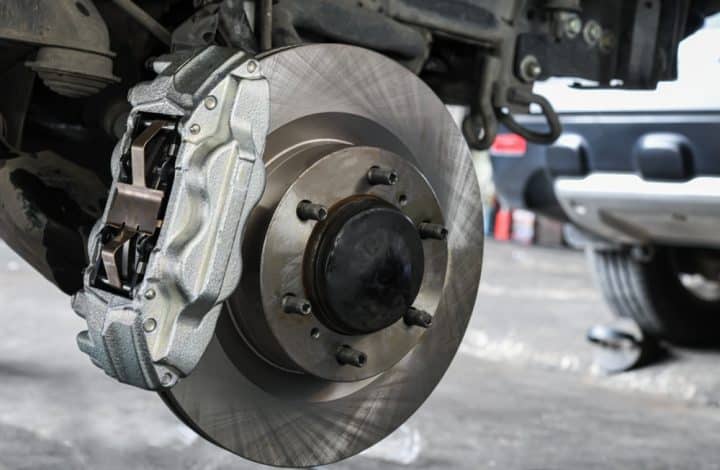Brake Discs
Your brake discs are working hard every time you slow down, with wear not always clearly announcing itself. Often, the signs build gradually: a longer stopping distance here, a slight change in pedal response there. By the time it feels obvious, the damage could already be affecting other parts of your braking system.
At Roade Main Garage in Northampton, we carry out brake disc and pad replacements regularly for local drivers. Our technicians know what early disc wear looks like, and how to stop a minor issue becoming something more serious.
We have a {{average-rating}} star Google rating from {{review-count}} satisfied customers in the Northampton and Milton Keynes area, and we’re proud to be trusted with safety-critical repairs.
In this guide, we’ll explain how brake discs work, what can cause them to fail, and when it’s time to get them checked.
Brake Discs and Their Role in Safe Stopping

Your brake discs are fixed to the wheel hub and rotate with the wheels as you drive. When you press the brake pedal, the brake pads are pushed against the spinning brake discs, creating friction. That friction slows the vehicle down by turning motion into heat.
Because this heat builds up fast, brake discs are made from cast iron, a material that can handle high temperatures while staying stable under pressure. Many vehicles have discs on all four wheels, although the front pair often take on the most braking force due to weight transfer.
Discs need to cool quickly between stops, which is why modern designs are carefully engineered to manage airflow. This helps maintain consistent braking power, even in demanding conditions like stop-start traffic or motorway driving.
At Roade Main Garage in Northampton, we inspect both front and rear brake discs during servicing. We don’t just measure thickness, we check for surface cracks, heat spots, discolouration, and uneven wear.
If a brake disc becomes too thin or starts wearing unevenly, you may notice a drop in braking performance, a pulsing sensation through the pedal, or visible damage behind the wheel spokes. Left too long, these issues can affect the pads, callipers, and fluid, turning a simple replacement into a more complex repair.
The Different Types of Brake Discs, And Why Fitment Matters
Not all brake discs are the same. Their design varies depending on the weight of the vehicle, the expected braking load, and the manufacturer’s original setup. That’s why we always check disc specification before carrying out any brake disc change at Roade Main Garage in Northampton.
Solid discs are usually found at the rear of lighter vehicles. They’re made from a single piece of cast iron and tend to suit braking systems where heat isn’t as intense. Vented discs, more commonly fitted at the front, contain internal vanes that draw in air while the disc spins, helping to cool the system more quickly under heavy braking.
Some discs are built for higher performance and include features like slotted grooves or drilled holes. These help reduce brake fade by letting gases and heat escape faster, and they can also improve grip in wet conditions.
You’ll also find discs made from advanced materials in certain high-performance or premium vehicles. These include ceramic or carbon fibre composites, chosen specifically for their strength, heat resistance, and low weight.
At Roade Main Garage, we never fit the incorrect type of brake discs. We match every component to the original spec and make sure it’s installed correctly, so your braking system continues to perform exactly as it should.
What Causes Brake Discs to Wear Prematurely
Brake discs are built to cope with high temperatures and repeated use, but they still wear out over time. The rate at which they wear depends on how the car is driven, the conditions it’s exposed to, and whether the braking system is working as it should.
At Roade Main Garage in Northampton, we often see discs wearing faster than expected for the following reasons:
Excessive heatRepeated hard braking, such as in stop-start traffic or steep descents, causes high thermal load. If the disc gets too hot, the cast iron can lose its strength and begin to warp or crack.
Driving habitsBraking late or applying pressure too aggressively increases surface friction. Over time, this accelerates wear and leads to heat damage or uneven disc thickness.
Improper bedding-in of new padsNew pads need time to form an even layer against the disc surface. If the car is driven too hard within the first 200 miles, the pads can leave uneven deposits of friction material behind. These high spots interfere with the contact between pad and disc, leading to thickness variation, brake judder, and inconsistent stopping power.
Sticking callipersIf a brake calliper doesn’t fully release, the pads may remain pressed against the disc while driving. This causes heat build-up and wears both the disc and pad prematurely.
Contamination on the hubEven a small amount of rust or dirt between the disc and hub can prevent proper seating. This misalignment leads to uneven pad contact, vibration, and premature wear.
Incorrect fittingIf the wheel bolts aren’t tightened evenly or to the correct torque setting, the disc can distort under pressure. At Roade Main Garage, we use calibrated torque wrenches on every job to ensure correct fitment.
Inferior partsUsing low-quality brake discs may reduce short-term costs but often leads to quicker deterioration. We only fit OEM-matching components that meet safety and performance standards.
If you’ve noticed any change in braking feel or noise, it’s worth booking a brake check. Identifying disc issues early can help avoid unnecessary strain on the rest of your system.

How to Spot the Signs of Brake Disc Wear
Brake discs don’t fail suddenly, but they do give you warning signs when something isn’t right. These include:
Vibration under brakingIf the pedal pulses or the steering wheel shakes when you slow down, it could point to a warped brake disc or uneven surface wear. This is especially noticeable at higher speeds or on downhill gradients.
Screeching or grinding noisesA squealing sound may indicate that the disc surface is rough, scored, or developing hotspots. A deeper grinding noise is more serious, often caused by extreme wear or pad material running low.
Visible damage through the wheelIf you can see cracks, discolouration, or uneven marks on the disc through the spokes of your alloy, it usually means the disc has been exposed to high heat or mechanical stress.
Unusual smell after brakingA sharp, chemical-like smell after frequent braking, such as in traffic or after a steep descent, may suggest a sticking calliper or overheating disc.
At Roade Main Garage, we check for all of these signs during a routine brake assessment. If you’re unsure whether it’s the discs, the pads, or something else in the braking system, we’ll pinpoint the cause and give you clear advice on what to do next. Additionally, our previous blogs on Brake Pads and our explainer on the Braking System will help you know more about how it all works.
What Happens If You Delay a Brake Disc Replacement
Brake disc issues rarely stay small for long. If you put off a brake disc replacement after signs of wear have appeared, the consequences can spread across the system, and put your safety at risk.
Weakened braking powerThin or heat-damaged discs lose their ability to dissipate heat properly. This leads to brake fade, where the system feels normal at the pedal but takes longer to stop the vehicle, especially during repeated braking.
Irreversible disc damageWarped or cracked discs can’t be repaired. Once structural damage sets in, full replacement is the only safe option. Continuing to drive with them increases the risk of total failure under load.
Increased vibrationUneven disc wear puts pressure on the braking system. This often results in pedal pulsing or steering wheel shake during deceleration, making the car feel unstable.
Brake fluid overheatingExcess heat from the discs can warm the brake fluid past its boiling point. When that happens, vapour bubbles form in the fluid, making it compressible, meaning the pressure from your foot doesn’t transfer properly. The result is a soft pedal and a sudden loss of stopping force.
Extra wear on other componentsWorn discs don’t just affect themselves. They can accelerate pad wear, strain the callipers, and even lead to heat transfer into nearby suspension or ABS parts.
At Roade Main Garage in Northampton, we check disc condition as part of every brake inspection. If a replacement is needed, we’ll explain exactly why, and make sure it’s fitted to spec with the correct tools and components.
Book a Brake Disc Check at Roade Main Garage in Northampton
If you’ve noticed changes in how your brakes feel, whether that’s a pulsing pedal, a sharp smell, or an unusual sound, it’s time to get them looked at. Brake discs rarely fail without warning, but once wear sets in, things can escalate quickly.
At Roade Main Garage in Northampton, we carry out detailed inspections on front and rear brake discs and pads. We check thickness, surface condition, signs of heat damage and fitment accuracy, comparing everything against the manufacturer’s spec.
If a replacement is needed, we only fit OEM-matching components using calibrated torque tools. Whether you need a brake disc change or a full set of discs and pads, we’ll make sure your system is safe, balanced and road-ready.
We’re proud to serve drivers across Northampton and Milton Keynes with reliable, safety-first brake repairs, backed by a 12-month parts and labour guarantee. And if you need to stay on the move, just ask about our courtesy car options.
We have a {{average-rating}} star Google rating from {{review-count}} satisfied customers, and we’re here to help.
📞 Call Roade Main Garage on 01604 862262 to book your brake check today.



